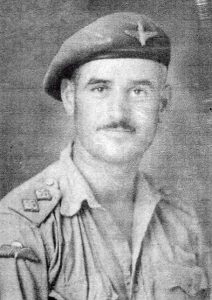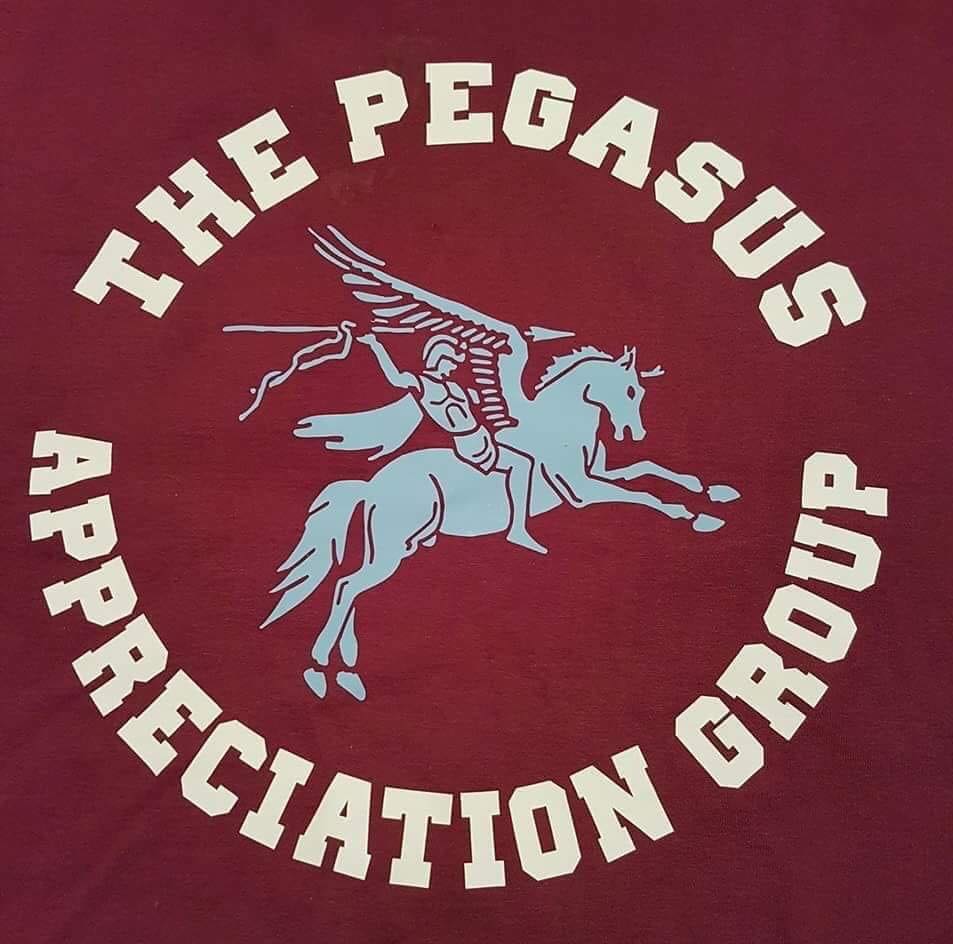LIEUTENANT Pat Glover was the 10th Battalion’s Quartermaster, a nd had previously seen service as a cavalryman with the 4th Queen’s Own Hussars.
nd had previously seen service as a cavalryman with the 4th Queen’s Own Hussars.
Glover was 35 years old, short and stocky in build, and had achieved fame in the Airborne world by adopting a chicken as a pet several months prior to Arnhem, training it as a parachutist. The story is well told under the heading ‘Myrtle the Parachick’.
On the 18th September 1944, the Battalion emplaned at Spanhoe airfield in Lincolnshire and after several hours of delay due to poor weather, eventually headed for Holland.
The formation ran into flak short of Arnhem and a few bursts hit Glover’s C-47, the noise of which he described as being similar to someone battering the aircraft with a sledgehammer.
Glover was to be the first man to jump from the plane, but he did not expect that the drop would be opposed. He could see, however, that a battle raged beneath his feet and that shots were coming up at them. For a moment, he wondered if they had been dropped in the wrong place. Mortars and shells were exploding everywhere and Ginkel Heath had been set ablaze; fires that some paratroopers fell into.
On the following day, as the Polish lift was coming down, the 10th Battalion withdrew across the railway line near Wolfheze at dusk, where they were holding the Brigade’s left flank, many of the Battalion had by now been killed, or wounded.
Glover recalled that the whole area was covered by German machine-gunners and so in the poor light men minimized their chances of being seen by going up the railway embankment, lying down, and then rolling themselves over the top.
Just as he was about to go over a determined German attack came in and the paratroopers dug themselves in at a pace.
On Wednesday 20th, Glover was at Battalion HQ at Wolfheze, by this time the Germans were all around their positions and the Battalion had become fragmented and no longer functioned as an organized unit.
Commanding Officer, Ken Smyth said “Look, I think we’ve had it. I’ve lost my command and I don’t know where we are. I think you’d better get in pairs and decide if you want to stick with me or go it on your own.”
Glover decided to stick with the Colonel. As dawn came the remains of the 10th Battalion’s companies were reunited with their HQ and so, dogged on two sides by German interference, they began to make their way south towards the Oosterbeek Perimeter. Nearing the edge of the British defence, what was left of the 10th Battalion, fixed bayonets, surged forward, and successfully broke into the Perimeter.
As he rested outside the Hartenstein, Glover heard the rumble of aircraft approaching and thought “Oh, my God, what next?”, but it only turned out to be the RAF bringing in supplies. Once they had completed their run and dropped their cargo, he and three other men retrieved what supply canisters they could find that had been dropped locally.
Glover was then ordered to visit the Oosterbeek crossroads, at the centre of the eastern side of the Perimeter, and report back on what 1st Airborne positions were in the area. Having conducted a reconnaissance and returned to the Hartenstein, he was told to go back. He found half a dozen men and set himself up in a house, but was later moved further forward and into a large building, a former restaurant, situated on the corner of a lane.
Along the lane was a German self-propelled gun that had been knocked out. The machine’s interior was smothered with blood, the breech block was missing, and there was a strong smell of diesel.
Glover knew immediately that the vehicle had been hit in its fuel tank, but in spite of this he was able to start the engine and allowed it 10 minutes to warm up.
Unfortunately in doing so, he made himself a target for both sides, because the British saw a functioning German tank, and the Germans knew that they had abandoned it and so presumed that it was about to be used against them.
Explosions went off around the tank and rocked it so much that it knocked Glover’s false teeth out. It was a terrible time for him, and his brave efforts were followed by much disappointment that he would not be able to use the tank to attack German positions, as it only managed 10 yards of movement before the engine gave way and packed up.
When dawn came on Thursday 21st, Glover took hold of a rifle and shot at German snipers that he could see in the vicinity, and believed he had hit three or four of them.
As is the danger with sniping, his position was eventually spotted and a shell was directed at his building which resulted in him falling from the first floor and into the room below. He was not injured as a result of this.
Later in the day, German soldiers put a great deal of machine-gun fire down on his building, but the parachutists put an end to this by charging across the road and driving them out.
With the situation stabilised for the moment, Glover turned his attention back to sniping and he was about to shoot a German moving across the green to the north of his position when a bullet hit his right hand and severed two veins.
This caused a great deal of blood, but in spite of a tourniquet, he could not stop the flow, so he made his way back to the Schoonoord dressing station a few hundred yards away.
Moving from house-to-house, he was shot at several times by snipers and received a further wound to his right calf when he was caught in a mortar explosion. However he otherwise reached the station intact.
He was helped into the back room, which had become the operating theatre -the whole room literally covered in blood – and he was lifted onto the makeshift operating table. The doctor informed him that morphia was in short supply, but that they would give him a shot if the pain proved too great, but Glover declined the offer and waved them on to continue.
On Friday 22nd, now a Prisoner of War, he and several other wounded men were loaded onto a horse and cart and taken to the St Elizabeth Hospital, thence to a prison hospital established at Apeldoorn.
A Dutch priest visited the men at Apeldoorn each Sunday and succeeded in giving vague directions to those who wished to escape and contact the Resistance by slipping a few extra words into the Lord’s Prayer.
Glover overheard the following: “Our Father, who art in heaven Captain Peter, Hallowed be thy name Underground, Give us this day Otterloo”. Though the instructions were hardly precise, Glover knew he should head for Otterloo and make contact with a Captain Peter of the Resistance.
On the 15th October, Glover’s 34th birthday, he escaped. He made it to the edge of the compound where he had to cross a road to reach the wire, however, the sentries on the road were too close together for him to have any chance of crossing without being spotted.
He waited for a while and wondered what he should do, when at last he heard the sound of an aircraft passing low overheard, and reasoning that the normal reaction of anyone on the ground would be to look up at it as it went above them, he bolted across the road as it came over and he was not seen.
The barbed-wire fence had cans tied to them to serve as an alarm if anyone tempted to cross them, but as well as a pair of wire cutters Glover also had the foresight to bring some string with him to tie the wires together to prevent the cans rattling as he cut through them. Once on the other side, he swam across the dike and, guided by an escape map and compass, proceeded to head in a southwesterly direction towards Otterloo.
Moving cautiously, it took him an entire day to find his way around Deelen Aerodrome. He spent most of the time in the woods, and when it rained he was in the habit of tying himself to the trunks of trees with a towel to ensure that when he slept it wasn’t on the wet ground.
Three or four days after his escape, he was tired, cold, and in dire need of nourishment when he happened to come across a farmhouse and decided to risk asking the owner to spare some food. The man who answered the door initially told Glover to go away, but he had a change of heart and told him to go and hide in the garden, where he was later hidden in a hole in the ground.
Three days later, a member of the Dutch Resistance came to the farm and briefly interviewed Glover before taking his leave, and on the following day another Resistance man came. However, this man, armed with a revolver, turned out to be no less than the mysterious Captain Peter himself.
Not long after, Glover was informed that he was to be evacuated to the Allied lines, he was just in time to join Pegasus I; the evacuation of mostly British Airborne troops across the Rhine.
Glover sat on the back of a bicycle which Captain Peter pedalled, and some time later along the road they met a column of some 2-300 German soldiers marching towards them. They decided to run the gauntlet and hope that they were not challenged.
After a while longer, they arrived in the woods where the 138 other men of Pegasus I were assembling for the journey to the riverbank. Taken down to the Rhine, Glover was in command of a small group of American servicemen, and for their successful evacuation he was awarded the US Bronze Star. He caught the last boat across the river, but they had to turn back because in their eagerness to get away, they had left behind the engineer who had guided the boat in.
From the southern bank of the Rhine, Glover was taken to a hospital in Nijmegen, and at the end of the month, all the men from Pegasus I were flown back to England. Upon going home Glover discovered that his wife had given birth to their third child, John Winston, on the 24th September. He died in 1996.
It seems improbable, and rather sad in a way, that Lt. Pat Glover, having fought so bravely through eight days of hell is perhaps better remembered for his adoption of ‘Myrtle the Parachick’!












